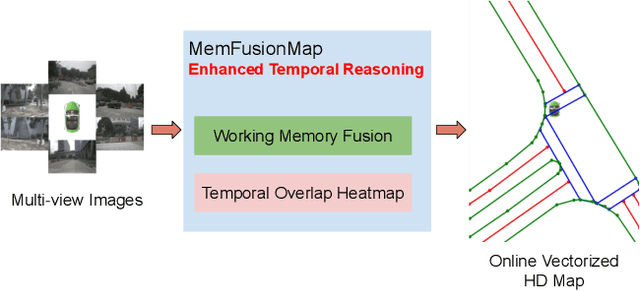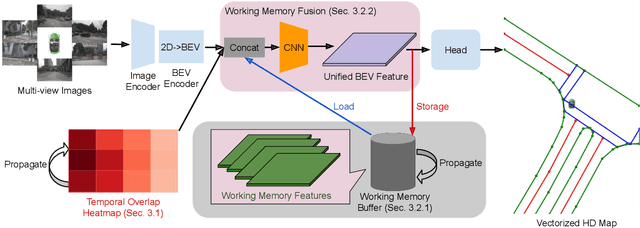Liupei Lu
MemFusionMap: Working Memory Fusion for Online Vectorized HD Map Construction
Sep 26, 2024



Abstract:High-definition (HD) maps provide environmental information for autonomous driving systems and are essential for safe planning. While existing methods with single-frame input achieve impressive performance for online vectorized HD map construction, they still struggle with complex scenarios and occlusions. We propose MemFusionMap, a novel temporal fusion model with enhanced temporal reasoning capabilities for online HD map construction. Specifically, we contribute a working memory fusion module that improves the model's memory capacity to reason across history frames. We also design a novel temporal overlap heatmap to explicitly inform the model about the temporal overlap information and vehicle trajectory in the Bird's Eye View space. By integrating these two designs, MemFusionMap significantly outperforms existing methods while also maintaining a versatile design for scalability. We conduct extensive evaluation on open-source benchmarks and demonstrate a maximum improvement of 5.4% in mAP over state-of-the-art methods. The code for MemFusionMap will be made open-source upon publication of this paper.
Leveraging Synthetic Data for Generalizable and Fair Facial Action Unit Detection
Mar 15, 2024



Abstract:Facial action unit (AU) detection is a fundamental block for objective facial expression analysis. Supervised learning approaches require a large amount of manual labeling which is costly. The limited labeled data are also not diverse in terms of gender which can affect model fairness. In this paper, we propose to use synthetically generated data and multi-source domain adaptation (MSDA) to address the problems of the scarcity of labeled data and the diversity of subjects. Specifically, we propose to generate a diverse dataset through synthetic facial expression re-targeting by transferring the expressions from real faces to synthetic avatars. Then, we use MSDA to transfer the AU detection knowledge from a real dataset and the synthetic dataset to a target dataset. Instead of aligning the overall distributions of different domains, we propose Paired Moment Matching (PM2) to align the features of the paired real and synthetic data with the same facial expression. To further improve gender fairness, PM2 matches the features of the real data with a female and a male synthetic image. Our results indicate that synthetic data and the proposed model improve both AU detection performance and fairness across genders, demonstrating its potential to solve AU detection in-the-wild.
 Add to Chrome
Add to Chrome Add to Firefox
Add to Firefox Add to Edge
Add to Edge